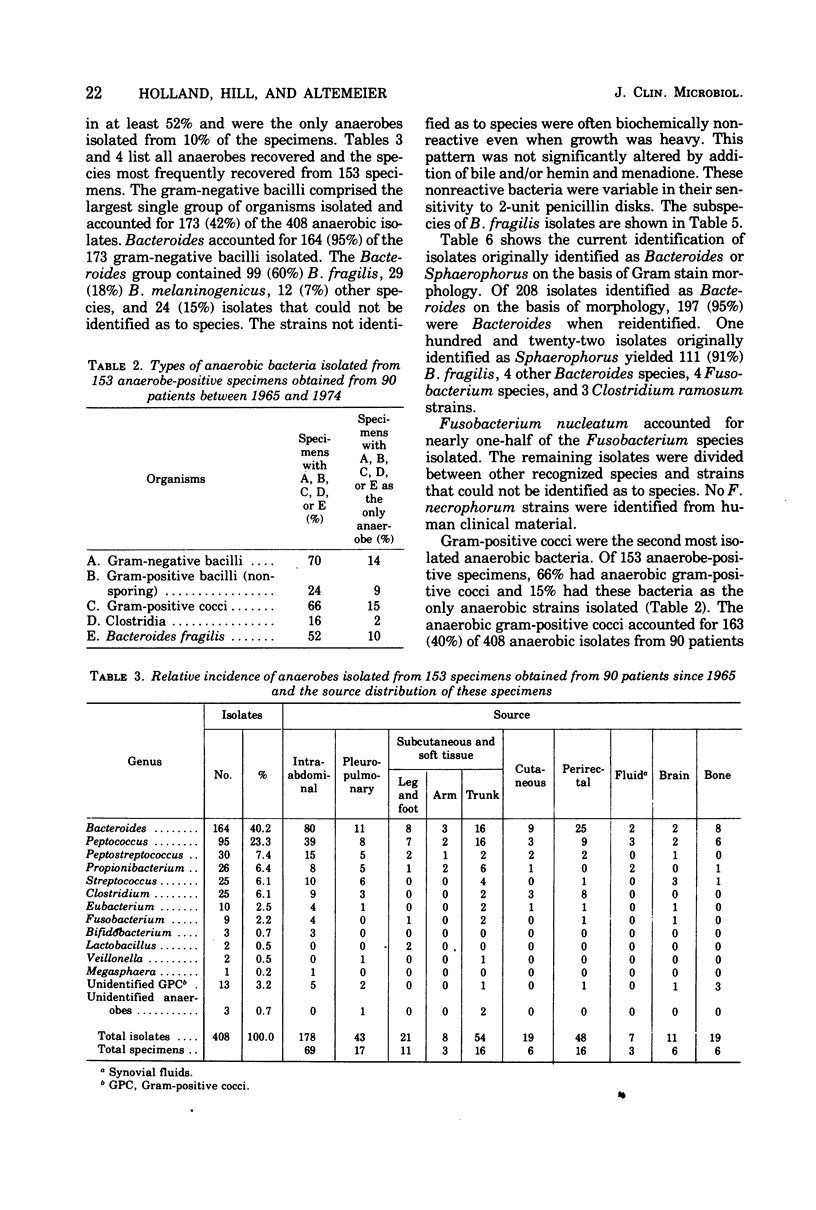Abstract
Between 1960 and 1974, 826 specimens, excluding stool, urine, sputum, and blood, yielded 689 (83%) positive cultures, of which 403 (58.5%) contained anaerobic bacteria. This represents 48.8% of the total specimens cultured. Isolates from 153 specimens obtained and stocked from 1965 to 1974 were reidentified by current criteria. Gram-negative bacilli, primarily bacteroides, were the most frequently isolated anaerobes, being found in 70% of 153 anaerobe-positive specimens and accounting for 42% of the total anaerobes isolated. Gram-positive cocci were second in occurrence, being found in 66% of 153 specimens and accounting for 40% of the total isolates. Bacteroides fragilis was by far the most frequently isolated species. Compairson of 14 years of cumulative data with data from current studies covering 1- to 2-year periods indicated that the anaerobes isolated from clinical material have not changed significantly in type or relative numbers.
Full text
PDF





Selected References
These references are in PubMed. This may not be the complete list of references from this article.
- Alpern R. J., Dowell V. R., Jr Clostridium septicum infections and malignancy. JAMA. 1969 Jul 21;209(3):385–388. [PubMed] [Google Scholar]
- Altemeier W. A., Schowengerdt C. G., Whiteley D. H. Abscesses of the liver: surgical considerations. Arch Surg. 1970 Aug;101(2):258–266. doi: 10.1001/archsurg.1970.01340260162025. [DOI] [PubMed] [Google Scholar]
- Altemeier W. A. THE BACTERIAL FLORA OF ACUTE PERFORATED APPENDICITIS WITH PERITONITIS: A BACTERIOLOGIC STUDY BASED UPON ONE HUNDRED CASES. Ann Surg. 1938 Apr;107(4):517–528. doi: 10.1097/00000658-193804000-00006. [DOI] [PMC free article] [PubMed] [Google Scholar]
- Dowell V. R., Jr Comparison of techniques for isolation and identification of anaerobic bacteria. Am J Clin Nutr. 1972 Dec;25(12):1335–1343. doi: 10.1093/ajcn/25.12.1335. [DOI] [PubMed] [Google Scholar]
- French R. S., Ziter F. A., Spruance S. L., Smith C. B. Chronic meningitis caused by Propionibacterium acnes. A potentially important clinical entity. Neurology. 1974 Jul;24(7):624–628. doi: 10.1212/wnl.24.7.624. [DOI] [PubMed] [Google Scholar]
- Killgore G. E., Starr S. E., Del Bene V. E., Whaley D. N., Dowell V. R., Jr Comparison of three anaerobic systems for the isolation of anaerobic bacteria from clinical specimens. Am J Clin Pathol. 1973 Apr;59(4):552–559. doi: 10.1093/ajcp/59.4.552. [DOI] [PubMed] [Google Scholar]
- Madeiros A. A. "Once, all the world was anaerobic". N Engl J Med. 1972 Nov 16;287(20):1041–1042. doi: 10.1056/NEJM197211162872009. [DOI] [PubMed] [Google Scholar]
- Martin W. J. Isolation and indentification of anaerobic bacteria in the clinical laboratory. A 2-year experience. Mayo Clin Proc. 1974 May;49(5):300–308. [PubMed] [Google Scholar]
- Moore W. E., Cato E. P., Holdeman L. V. Anaerobic bacteria of the gastrointestinal flora and their occurrence in clinical infections. J Infect Dis. 1969 Jun;119(6):641–649. doi: 10.1093/infdis/119.6.641. [DOI] [PubMed] [Google Scholar]
- Mueller J. H., Miller P. A. A Modification of Rosenthal's Chromium-Sulfuric Acid Method for Anaerobic Cultures. J Bacteriol. 1941 Mar;41(3):301–303. doi: 10.1128/jb.41.3.301-303.1941. [DOI] [PMC free article] [PubMed] [Google Scholar]
- Pien F. D., Thompson R. L., Martin W. J. Clinical and bacteriologic studies of anaerobic gram-positive cocci. Mayo Clin Proc. 1972 Apr;47(4):251–257. [PubMed] [Google Scholar]
- Rosenblatt J. E., Fallon A., Finegold S. M. Comparison of methods for isolation of anaerobic bacteria from clinical specimens. Appl Microbiol. 1973 Jan;25(1):77–85. doi: 10.1128/am.25.1.77-85.1973. [DOI] [PMC free article] [PubMed] [Google Scholar]
- Rosenthal L. "Chromium-Sulphuric Acid" Method for Anaerobic Cultures. J Bacteriol. 1937 Sep;34(3):317–320. doi: 10.1128/jb.34.3.317-320.1937. [DOI] [PMC free article] [PubMed] [Google Scholar]
- STOKES E. J. Anaerobes in routine diagnostic cultures. Lancet. 1958 Mar 29;1(7022):668–670. doi: 10.1016/s0140-6736(58)91087-0. [DOI] [PubMed] [Google Scholar]
- Thadepalli H., Gorbach S. L., Broido P. W., Norsen J., Nyhus L. Abdominal trauma, anaerobes, and antibiotics. Surg Gynecol Obstet. 1973 Aug;137(2):270–276. [PubMed] [Google Scholar]
- Zabransky R. J. Isolation of anaerobic bacteria from clinical specimens. Mayo Clin Proc. 1970 Apr;45(4):256–264. [PubMed] [Google Scholar]


